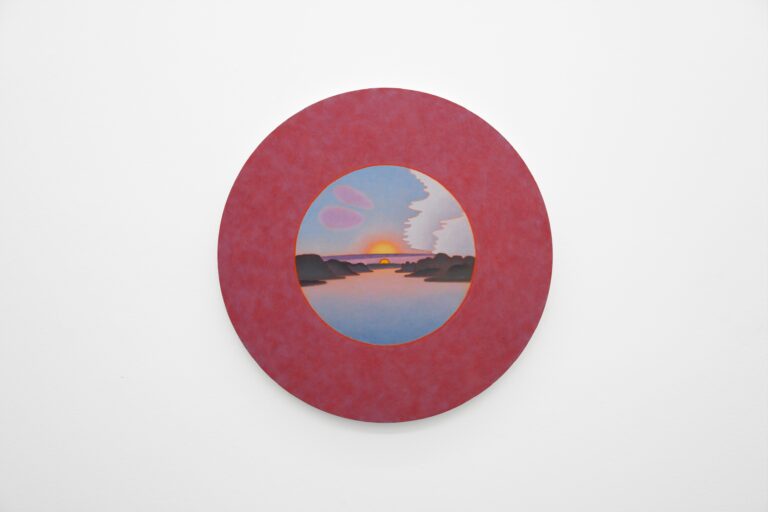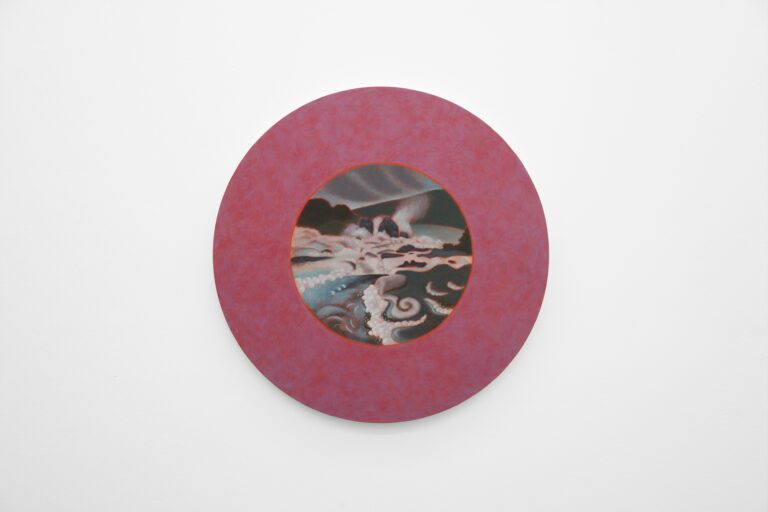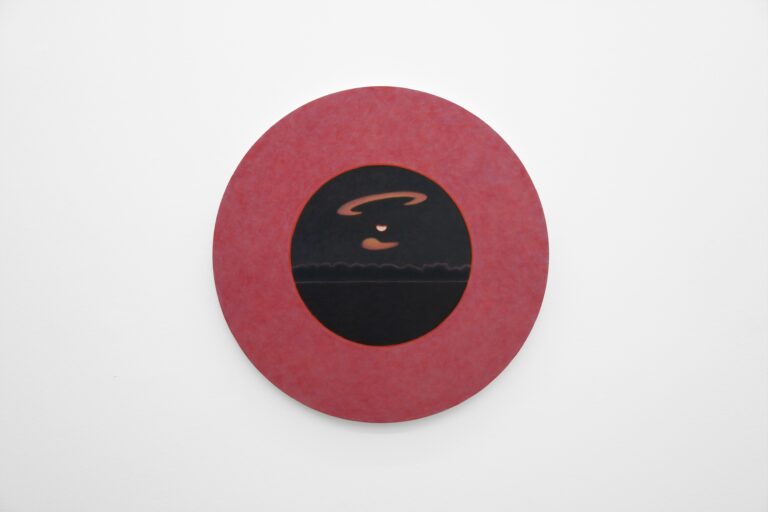Published 28 AUG 2024
Caroline Bachmann
Le Rhin
Opening – 12 SEP 2024, 6-9 pm
13 SEP till 26 OCT 2024

Le Rhin XXIII, 2024
oil on wood
Ø 60 cm
Courtesy of the artist and Meyer Riegger
For her Rhine series, Caroline Bachmann embarked on two journeys along the river – one shorter, one slightly longer. The latter was an eight-day boat trip along the Rhine from Basel to Rotterdam in October 2023. Two months later, she drove by car for almost four hours from her home in Cully on Lake Geneva to Reichenau in the Swiss canton of Graubünden, where the Vorderrhein and Hinterrhein rivers meet, to see the birthplace of the Alpine Rhine. If visitors begin their tour of the exhibition on the first floor of Meyer Riegger and then go down to the ground floor, they can also follow the course of the river from Reichenau to Rotterdam.
As if looking through the porthole of a ship, a telescope or a keyhole, Bachmann presents her depictions of the Rhine in round frames. One of the most famous round paintings is Michelangelo Buonarroti’s Tondo Doni (1505/1506), a portrait of the Holy Family on display in the Uffizi Gallery in Florence. Like Michelangelo, Bachmann paints on wood. However, the diameter of her work is exactly half that of the Italian Renaissance painting – sixty centimetres. While there is only a hint of the landscape in the background of Michelangelo’s work, Bachmann’s paintings are entirely landscape. Although that in itself is nothing new, the decision to start painting landscapes in the 2000s, as Bachmann did, certainly required courage. Still, the question remains as to whether it is possible to add anything new to this art historical genre.

Le Rhin VIII, 2024
oil on wood
Ø 60 cm
Courtesy of the artist and Meyer Riegger
Twenty-four views of the Rhine are not that many at all when you compare this figure with the number of pictures of Lake Geneva that Bachmann has painted to date. The artist first began painting the lake at dawn twelve years ago. Although the landscape is the same every time – the mountains, the surface of the water, the sky – each work is unique. In fact, the repetition of this motif leads to a kind of paradox for Bachmann: the more often she paints the same motif, the less familiar the place feels, and the more interesting it seems to explore.
While Bachmann always draws the sketches for her paintings of Lake Geneva from the same position in Cully, the Rhine series portrays the course of the river from different perspectives. Sometimes the Rhine looks more like a rivulet, sometimes it meanders its way between rocks, sometimes it rushes – but mostly it flows calmly and meditatively along.

oil on wood
Ø 60 cm
Courtesy of the artist and Meyer Riegger
The artist’s method of working always remains the same: she begins by drawing quick pencil sketches outdoors and noting down the different colours and elements. During her trips along the Rhine, Bachmann produced around one hundred of these sketches; she then selected twenty-four and transformed them into paintings in her studio in Cully. While landscape painters such as Ferdinand Hodler and Giovanni Segantini always painted en plein air, namely in the open air, Bachmann prefers to retreat to her ‘cave’, as she refers to her studio. This separation from the original experience of nature – working in artificial light without a direct view of the landscape – is essential for Bachmann’s painting process, which is very slow. This way of working means that her paintings are characterised by different experiences of time: the swiftness of sketching gives way to the more laborious painting phase, during which the artist slowly resurrects the spontaneous encounter with nature that she experienced while sketching. This approach, which focuses on the superimposition of different temporal levels, proves that Bachmann does indeed have something to add to the history of landscape painting. The artist always creates her paintings cyclically in groups, painting up to ten pictures simultaneously over periods lasting several months. While one layer is drying, she turns to another work. She applies the paint in extremely thin coats and uses very fine brushes that barely leave a trace. Bachmann compares the short sketching phase that precedes the longer painting process to fishing. She waits, and then as soon as she sees something interesting, everything happens very quickly. Because Bachmann establishes a connection while painting to the sensations she felt while sketching, her images represent not so much a naturalistic reality as the (re-)experience of her own individual perception. Bachmann describes the process of painting, drying and waiting to add a new layer as a form of sedimentation: “When I paint, things mix together and then it’s as if they’re sinking to the bottom.”1
Bachmann’s paintings thus enable us viewers to experience time differently, too. Contrary to its usual linear course, the twenty-four-hour cycle of a day, Bachmann creates temporal connections in her works that are not chronological. She explains: “When it works, it’s as if the painting were suddenly dilating space and time and inviting us, as we stand face to face with it, to be part of all those times at the same time.”2
Her pictures preserve a feeling. And perhaps they – along with the time she devotes to them – also reflect her respect for the landscape. A respect that most people lost a long time ago: the Rhine, for example, was straightened at the beginning of the nineteenth century. Its meanders were regulated and the entire river was confined to a narrower bed. Of course, this was not carried out because it was beneficial to nature. The aim was to create clear boundaries, make the river navigable for ships, avoid flooding and to utilise the flow of water as a resource.
Instead of utilising the energy of the Rhine, Bachmann conserves it. The bright orange colour at the edge of the image flickers so forcefully that it looks as if it is about to burst. The frame – which is not round, but also appears in rectangular form in her paintings of Lake Geneva – “stops the energy from overflowing, it contains it and allows it to circulate between the painting and me. The time that goes into it is what makes the painting.”3 If we take some time to look – the average time spent in front of a painting in a museum is just fifteen seconds – then perhaps we can fully understand the intensity of this experience of nature.
Text: Alicja Schindler
1 Caroline Bachmann in conversation with Yann Chateigné Tytelman, ‘Questions of vision’, in Prix Meret Oppenheim 2022, ed. Swiss Federal Office of Culture (Bern, 2022), p. 201.
2 Ibid., p. 211.
3 Julie Enckell (ed.), Caroline Bachmann (Zurich, 2022), p. 47.
